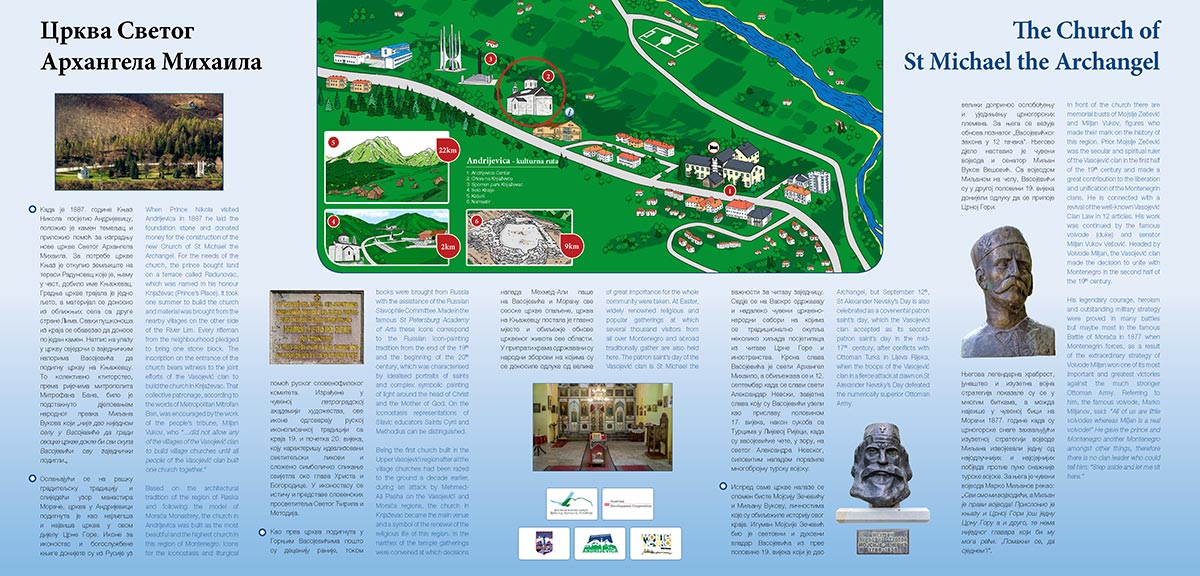When Prince Nikola visited Andrijevica in 1887 he laid the foundation stone and donated money for the construction of the new Church of St Michael the Archangel. For the needs of the church, the prince bought land on a terrace called Radunovac, which was named in his honour Knjaževac (Prince’s Place). It took one summer to build the church and material was brought from the nearby villages on the other side of the River Lim. Every rifleman from the neighbourhood pledged to bring one stone block. The inscription on the entrance of the church bears witness to the joint efforts of the Vasojević clan to build the church in Knjaževac. That collective patronage, according to the words of Metropolitan Mitrofan Ban, was encouraged by the work of the people’s tribune, Miljan Vukov, who “…did not allow any of the villages of the Vasojević clan to build village churches until all people of the Vasojević clan built one church together.”
Based on the architectural tradition of the region of Raska and following the model of Morača Monastery, the church in Andrijevica was built as the most beautiful and the highest church in this region of Montenegro. Icons for the iconostasis and liturgical books were brought from Russia with the assistance of the Russian Slavophile Committee. Made in the famous St Petersburg Academy of Arts these icons correspond to the Russian icon-painting tradition from the end of the 19th and the beginning of the 20th century, which was characterised by idealised portraits of saints and complex symbolic painting of light around the head of Christ and the Mother of God. On the iconostasis representations of Slavic educators Saints Cyril and Methodius can be distinguished.
Being the first church built in the Upper Vasojevići region after all the village churches had been razed to the ground a decade earlier, during an attack by Mehmed- Ali Pasha on the Vasojevići and Morača regions, the church in Knjaževac became the main venue and a symbol of the renewal of the religious life of this region. In the narthex of the temple gatherings were convened at which decisions of great importance for the whole community were taken. At Easter, widely renowned religious and popular gatherings at which several thousand visitors from all over Montenegro and abroad traditionally gather are also held here. The patron saint’s day of the Vasojević clan is St Michael the Archangel, but September 12th, St Alexander Nevsky’s Day is also celebrated as a covenental patron saint’s day, which the Vasojevići clan accepted as its second patron saint’s day in the mid- 17th century, after conflicts with Ottoman Turks in Lijeva Rijeka, when the troops of the Vasojević clan in a fierce attack at dawn on St Alexander Nevsky’s Day defeated the numerically superior Ottoman Army.
In front of the church there are memorial busts of Mojsije Zečević and Miljan Vukov, figures who made their mark on the history of this region. Prior Mojsije Zečević was the secular and spiritual ruler of the Vasojević clan in the first half of the 19th century and made a great contribution to the liberation and unification of the Montenegrin clans. He is connected with a revival of the well-known Vasojević Clan Law in 12 articles. His work was continued by the famous voivode (duke) and senator Miljan Vukov Vešović. Headed by Voivode Miljan, the Vasojević clan made the decision to unite with Montenegro in the second half of the 19th century.
His legendary courage, heroism and outstanding military strategy were proved in many battles but maybe most in the famous Battle of Morača in 1877 when Montenegrin forces, as a result of the extraordinary strategy of Voivode Miljan won one of its most important and greatest victories against the much stronger Ottoman Army. Referring to him, the famous voivode, Marko Miljanov, said: “All of us are little voivodes whereas Miljan is a real voivode!” He gave the prince and Montenegro another Montenegro amongst other things, therefore there is no clan leader who could tell him: “Step aside and let me sit here.”



